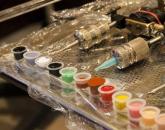Paris - Middle Ages and Renaissance. New arrivals in the electronic collection of emigrant publications of the House of Russian Abroad named after
Savine Annotation: January 1949 - March 1974. For 26 years of existence, 243 issues have been issued. Set. Publishing font covers. Very good preservation. The first editor and main founder and ideologist of the "Renaissance" was P. B. Struve, who was guided by the state, imperial ideas of K. Leontiev and his cult of the Fatherland. The history of the emergence and entire existence of the journal is as follows: at first, Vozrozhdenie was a large daily newspaper of the "right" wing, conceived and published as a counterbalance to the "left" press abroad. The first issue of the newspaper was published on June 3, 1925. In the early thirties, Yu. F. Semenov replaced P. B. Struve as editor. He retained the direction given to the newspaper by its first editor and founder. This direction was preserved until the end of the existence of the "Renaissance". Since 1936, during the time of the "popular front", when it became difficult for the right-wing press to exist, the newspaper became a weekly newspaper. On June 7, 1940, on the eve of the entry of the Germans into Paris, the publication was temporarily discontinued. The years of war and occupation passed, and Vozrozhdenie began to be published as a magazine from January 1949. From 1 to 108 issues, from January 1949 to December 1960, the magazine was published under the name "Literary-Political Notebooks", "Renaissance". From 109 to 216 issues, from January 1961 to December 1969, the magazine was called: "Renaissance, a monthly literary and political magazine." From issues 217 to 243, the magazine began to bear the subtitle "Independent Literary and Political Journal". The first issue of the journal was edited by I. I. Tkhorzhevsky, then S. P. Melgunov became the editor, and finally, Prince S. S. Obolensky and Ya. N. Gorbov. The journal was divided into the following sections: literature, poetry, criticism, bibliography, politics, chronicle of events, memories of the Civil War, annals of emigration, events in modern Russia , discussions, architecture, cinema, theater, ballet, a Russian necropolis abroad… Poems, prose, memoirs, archival materials, a chronicle of cultural and literary life in emigration… The following authors were published in the journal: Odoevtseva, Adamovich, Teffi, Shmelev, Zaitsev , Bunin, Stepun, Zlobin, Ulyanov, G. Struve, I. Tkhorzhevsky, Yu. Annenkov, Karateev, Berberova, T. Velichkovskaya, I. Chinnov, Maevsky, M. Vega, Yu. Ivask, Prince S. S. Obolensky, A. Shimanskaya, N. Narokov, 3. Shakhovskaya, M. Goldstein, I. Bilibin, M. Hoffman, D. Merezhkovsky, S. Lifar, P. E. Kovalevsky, N. Healed, Yu. Odarchenko, B. Pasternak, V. Zlobin, A. Tyrkova-Williame, N. Fedorova, Iv. Lukash, V.N. Muromtseva-Bunina, V.N. Ilyin, Iv. Drozdov, 3. Gippius, I. Sagatsky, N. N. Evreinov, A. M. Remizov, M. Voloshin, S. Makovsky, Yu. Krusenstern - Peterets, K. Pomerantsev, L. Nord, B. Vysheslavtsev, V. Smolensky, V. Unkovsky, G. Ivanov, V. Maklakov, V. Ryabushinsky, E. Tauber, S. Rafalsky, G. Grebenshchikov, N. Turoverov, L. Wrangel, S. Yablonovsky, P. B. Struve, A. Kartashev, A. Denikin, P. D. Bark, General Maslovsky, French poets in Russian translations, B. Poplavsky, V. Pereleshin, G. K. Gins, A. Kashina-Evreinova and many other well-known and less well-known authors of Russian abroad . The journal published the most valuable critical literary materials and memoirs about Lossky, Tchaikovsky, Akhmatova, Teffi, Pasternak, Khodasevich, Chagall, Berdyaev, Platonov, Blok, Chekhov, Turgenev, Kuprin, Mendeleev, N. Otsup, Remizov, Anna Pavlova, unpublished letters from collections of Lifar, foreign Pushkiniana, materials about Lenin, Gumilyov, Gogol, A. N. Benois ... "Vozrozhdeniye" is among such major periodicals in the Russian diaspora as "Modern Notes", "Russian Notes" and is, as it were, their continuation. "Vozrozhdenie" was issued in parallel with the "New Journal" and was its addition. It is very difficult to pick up a complete set of the magazine, the issues published in the seventies are extremely rare, the circulation of which did not exceed 300 copies, and few people in exile thought about preserving the whole set. Materials on the history of the Russian press in emigration. An indispensable reference material for Slavists, historians of Russian literature, historians of Russian art, bibliographers, historians of Russia. Exceptional rarity in the set. [notebook]. The first editor and main founder of the ideology of the Renaissance was P. B. Struve, who based the Renaissance on the state, imperial ideas of Konstantin Leontiev, on his cult of the Fatherland. In the beginning, Vozrozhdeniye was a large right-wing (but not fascist or autocratic) daily newspaper, conceived and published in opposition to the left-wing press of the Russian emigration. Its first issue was published on June 3, 1925. As editor, Struve was replaced by Yu. F. Semenov, who retained in the newspaper the character that its first editor gave it and who remained in Vozrozhdeniye to the end. Since 1936, the newspaper became a weekly newspaper, during the time of the Popular Front, when it was difficult for the right-wing press to exist, and on June 7, 1940, on the eve of the Germans' entry into Paris, the publication was temporarily discontinued. The years of war and occupation passed, and "Vozrozhdeniye" resumed its existence in January 1949, and by December 1954 it had already been published six times in the form of literary and political notebooks. From January 1955 until the end, the magazine was published monthly. After the Second World War, the Russian emigration experienced troubled times: the mood of the emigrants, partly due to the lack of truthful information, partly fueled by the outbreak of patriotism after the victory of Russia: it was pro-Soviet ... The magazine, which steadily stood on the right anti-Bolshevik positions, accepted into its ranks writers who did not want and could not be published in the press of the left, monarchically minded, standing on the positions of the right, national-patriotic character: Surguchev, Shmelev, Odoevtsev, G. Ivanov and others. literature of Di-pi, or the second, military emigration), whose representatives were Ulyanov, Velichkovskaya, Chinnov, and others. The magazine published the first testimonies about Russia of people who left Russia during the war, about the German occupation of Russia, about the Vlasov army and the Vlasovites. "Renaissance" played a big role in the life of the cultural Russian emigration, reflecting the thoughts and moods of the national-patriotic part of the Russian emigration, serving the cause of liberating Russia from the communist regime, reminding the Russian emigration of the debts and obligations that fell to its lot, also serving the Russian emigration, emphasizing her positive sides and protecting her interests. The magazine was and remains a monument to the vitality and fruitfulness of the Russian emigration, despite all the assertions about the futility, uselessness and simply absence of Russian emigrant culture. [card]. Savine Citation: [b. pp.] Staff Notes: Monthly Illustrated Magazine: No. 1-243: set. Approximately 200 pages per issue.; IN different years the journal was called: Literary-political notebooks; Renaissance; Vozrozhdeniye, monthly literary and political magazine; Vozrozhdeniye, an independent literary and political journal.; Savin also attached a copy (2 pages) from the Russian Bibliophile catalogue. Topical Subjects: Contributors:
Paris in the Middle Ages was not at all a cozy and brilliant city. The streets were cramped, and often turned into sewers, as there was no sewerage system in the Middle Ages. Pets easily roamed the streets, which could often provoke accidents. Residents could ride horses or mules around the city, as carriages could not pass in narrow quarters.
And yet, Paris developed rapidly. Thanks to the Sorbonne, the city is turning into a European center of knowledge. In order for students to live within the city, a campus arises, called the Latin Quarter, in honor of the language in which education was conducted within the walls of the Alma Mater.
Place de la Concorde photo 1.
The city was overgrown with the rich abbeys of Saint-Germain and Saint-Genevieve on the left bank of the Seine, and the right bank was chosen by the monastic order of the Templars by building the Temple fortress, and the abbey of Saint-Martin de Champs was also located there.
During these times, the first dissatisfaction with the royal power arises. In 1356, the British managed to win the battle of Poitiers, capturing the French king John II. The elder of the Parisian merchants Etienne Marcel, taking advantage of the weakened royal influence, organizes a rebellion.
A year later, the uprising was brutally suppressed. Marseille is killed and the future King Charles V restores royal authority. Strengthening his power, Charles V expands the Louvre, builds the Bastille, strengthens the banks of the Seine.
And even in these troubled times, the city continued to grow, but numerous epidemics and wars claimed the lives of the Parisians. In 1419, Paris was captured by the British, which led to the fact that in 1431, King Henry VI of England was crowned at Notre Dame. After 5 years, Paris was returned to the French.

Luxembourg Palace photo2.
The Renaissance came to Paris with Francis I (1515–1547). The Louvre is being reconstructed into a luxurious palace, an elegant town hall building is being erected. The Seine is overgrown with magnificent mansions. It would seem that the city is now blooming and prettier. But it is not for nothing that the word "Parisians" has the meaning of "troublemakers." The city is shaking religious wars. Catholics stand up to the persecution of Protestants. Thousands were killed on the night of August 23, 1572, this senseless massacre still bears the common name St. Bartholomew's Night. The instability of the royal power leads to starvation of 13 thousand inhabitants of Paris during the siege of the city.

Tuileries Garden photo 3.
The long-awaited peace comes during the reign of Henry IV (1589-1610), the founder of the Bourbon dynasty. The Edict of Nantes put an end to religious strife in 1598. Over the next two hundred years, the city became not only the largest European capital, but also the center of culture. Each king contributes to the improvement of the city. New avenues are being laid. The Louvre is expanding. Seine is now decorated with stone bridges.
Palaces are being built for royal mothers: the Tuileries Palace for the Queen Mother Catherine de Medici, the Luxembourg Palace for Marie de Medici, the Val de Grace for Anne of Austria. Cardinal Mazarin builds a new educational building, which later became the French Academy.
Despite the obvious rejection of the city, Louis XIV also contributes to the development of Paris. Orders to build a monumental complex Les Invalides. The area near the Louvre is being ennobled, the Tuileries Garden and the Champs Elysees are being laid out. Architect Le Notre innovates radial avenues from Place de la Concorde.
New Arrivals
to the electronic collection of emigrant publications
Houses of the Russian Diaspora A. Solzhenitsyn
House of Russian Diaspora A. Solzhenitsyn has been actively engaged in the digitization of his , solving the problems of preserving rare paper originals and providing wide access to information. Access to electronic collections is provided free of charge to visitors of the Library of the House in the local computer network.
They occupy an important place in the digitization program - a valuable source for studying the history of the Russian emigration of the 20th century. However, due to poor preservation and significant gaps in the completeness, they are among the most difficult to access for researchers. In order to restore the completeness of the sets, under agreements with other depositories, numbers that are not in the House's library are digitized.
So, at the end of 2013, a large joint project was completed with the scientific library of the State Archives of the Russian Federation to create an electronic version of the Parisian newspaper Vozrozhdenie.
The Vozrozhdenie newspaper (Paris, 1925-1940, 4239 issues) is one of the most authoritative periodicals of the Russian diaspora. The first chief editor of the newspaper was P.B. Struve, who wrote in a program editorial that, in addition to the “relentless struggle against the abomination and shame of the communist yoke” and the task of liberation, “the authoritative and authoritative voice of history is calling for a creative revival of the national spirit and national existence. ... To liberate and be freed in order to revive and be reborn. The newspaper adhered to this direction until June 7, 1940, when the publication was "temporarily stopped on the eve of the entry of the German army into Paris." From 1949 to 1974, the eponymous book began to appear in Paris. .
On the pages of the newspaper, many burning problems of our time found a response, and there were active discussions about the fate of Russia. Today, the newspaper serves as a valuable source of information about Everyday life the first wave of Russian emigration, societies and organizations, events in the field of culture and art. Among the authors of the "Renaissance" one can name such names as A.V. Amfiteatrov, N.N. Berberova, I.A. Bunin, Z.N. Gippius, Don-Aminado, V.V. Zenkovsky, I.A. Ilyin , K.A. Korovin, S.P. Melgunov, D.S. Merezhkovsky, P.P. Muratov, I. Severyanin, P.A. Sorokin, F.A. Stepun, G.P. Struve, I.D. .Surguchev, Yu.K.Terapiano, N.N.Turoverov, N.A.Teffi, V.F.Khodasevich, I.S.Shmelev and many others. Without referring to the materials published on the pages of the Vozrozhdenie newspaper, the idea of the history of the Russian diaspora in the interwar period will not be complete enough.
Unfortunately, today in Russia there is not a single repository where the entire set of this publication would be presented. The most complete selection has just Library of the State Archives of the Russian Federation , where the newspaper files ended up as part of the RZIA collections. And it is this kit that is now available to visitors of the DRZ and GARF in in electronic format. More detailed information about the newspaper and a list of available electronic versions of the issues can be obtained on the newspaper's page on the website "Emigrant" - a consolidated catalog of periodicals of the Russian diaspora.
Remote users can order copies of individual articles from the electronic versions of the numbers available in the DRG at . Services are provided on a paid basis.
In 2013, a joint project was also completed with House-Museum of M.I. Tsvetaeva on the digitization of another interesting edition of the Russian abroad - weekly "Illustrated Russia" (1924-1939, 748 rooms), with which such artists as A.N. Benois, I.Ya. Bilibin, K.A. Korovin, F.A. Malyavin, F.S. D.S. Stelletsky, A.E. Yakovlev, the famous cartoonist MAD (M.A. Driso). Now almost the entire set of the magazine is available to visitors of both the M.I.
The Library of the House of Russian Abroad has accumulated extensive experience in this area, is ready for new projects and offers other partners cooperation in the preservation and promotion of the cultural heritage of the Russian emigration.
The publishing house existed from January 1949 to March 1974. For 26 years, he published 243 issues of the same-name publication.
The first editor and main founder and ideologist of the "Renaissance" was P. B. Struve, who was guided by the state, imperial ideas of K. Leontiev and his cult of the Fatherland. The history of the emergence and entire existence of the journal is as follows: at first, Vozrozhdenie was a large daily newspaper of the "right" wing, conceived and published as a counterbalance to the "left" press abroad. The first issue of the newspaper was published on June 3, 1925. In the early thirties, Yu. F. Semenov replaced P. B. Struve as editor. He retained the direction given to the newspaper by its first editor and founder. This direction was preserved until the end of the existence of the "Renaissance".
Since 1936, during the time of the "popular front", when it became difficult for the right-wing press to exist, the newspaper became a weekly newspaper. On June 7, 1940, on the eve of the entry of the Germans into Paris, the publication was temporarily discontinued. The years of war and occupation passed, and Vozrozhdenie began to be published as a magazine from January 1949. From 1 to 108 issues, from January 1949 to December 1960, the magazine was published under the name "Literary-Political Notebooks", "Renaissance". From 109 to 216 issues (from January 1961 to December 1969) the magazine was called: "Vozrozhdeniye, a monthly literary and political magazine." From issues 217 to 243, the magazine began to bear the subtitle "Independent Literary and Political Journal".
The first issue of the journal was edited by I. I. Tkhorzhevsky, then S. P. Melgunov became the editor, and finally, Prince S. S. Obolensky and Ya. N. Gorbov.
The magazine was divided into the following sections: literature, poetry, criticism, bibliography, politics, chronicle of events, memories of the Civil War, chronicle of emigration, events in modern Russia, discussions, architecture, cinema, theater, ballet, Russian necropolis abroad ... Poetry, prose , memoirs, archival materials, a chronicle of cultural and literary life in exile...
The magazine published the first testimonies about Russia of people who left Russia during the war, about the German occupation of Russia, about the Vlasov army and the Vlasovites. "Renaissance" played a big role in the life of the cultural Russian emigration, reflecting the thoughts and moods of the national-patriotic part of the Russian emigration, serving the cause of liberating Russia from the communist regime, reminding the Russian emigration of the debts and obligations that fell to its lot, also serving the Russian emigration, emphasizing its positive sides and protecting its interests.
The magazine published: Odoevtseva, Adamovich, Teffi, Shmelev, Zaitsev, Bunin, Stepun, Zlobin, Ulyanov, G. Struve, I. Tkhorzhevsky, Yu. Annenkov, Karateev, Berberova, T. Velichkovskaya, I. Chinnov, Mayevsky, M. Vega, Yu. Ivask, Prince S. S. Obolensky, A. Shimanskaya, N. Narokov, B. Pasternak, 3. Gippius, P. B. Struve, A. Kartashev, A. Denikin, P. D. Bark, French poets in Russian translations, and many other well-known and less well-known authors of the Russian diaspora.
The journal published the most valuable critical literary materials and memoirs about Lossky, Tchaikovsky, Akhmatova, Teffi, Pasternak, Khodasevich, Chagall, Berdyaev, Platonov, Blok, Chekhov, Turgenev, Kuprin, Mendeleev, Remizov, Anna Pavlova, unpublished letters from the collection of Lifar, foreign Pushkinian, materials about Lenin, Gumilyov, Gogol, A. N. Benois ...
Vozrozhdenie is among such major periodicals in the Russian diaspora as Sovremennye zapiski and Russkiye zapiski and is, as it were, a continuation of them. "Vozrozhdenie" was issued in parallel with the "New Journal" and was its addition.
Among others, the publishing house published such books as:
Gurko V.I. Tsar and Tsarina: [about Nicholas II and Empress Alexandra Feodorovna]. - Paris: Renaissance, 1927. - 123p. Korchemny V. Man with geranium. - Paris: Renaissance, . - 213s.
Lukash I.S. Snowstorm. - Paris: Renaissance, 1936. - 253p.
Lyubimov L.D. The Secret of Emperor Alexander I. - Paris: Renaissance, 1938. - 219p.
Novikov V.N. Fascism: Essays on Italian fascism with the text of the law April 3, 1926 appended. oh fascist. syndicates. - Paris: Renaissance, . - 121s.
Polovtsov P.A. Eclipse Days: (Notes of the Commander-in-Chief of the Petrograd Military District). - Paris: Renaissance, . - 207s.
Popov K.S. Temple of Glory: At 2 o'clock - Paris: Renaissance, 1931. Part 2. – . - 247s., 10l. ill.
The murder of Voikov and the case of Boris Koverda. – Paris: Renaissance, [after 18927]. - 118s., 1l. portrait
Yablonovsky A.A. Street children. - Paris: Renaissance, 1928. - 233p.
Popular
- Confectionery business plan with calculations - how to open a confectionery business plan for a home confectionery sample with calculations
- Business plan for a tire shop What you need for a truck tire fitting
- How to open a taxi service: the nuances of doing business
- The most promising business ideas from America
- How to open a .DSF file? How to open DSF? Sponsor Information
- Features of the presentation of tourism services on the example of the travel agency "Hot Tours" (g
- Ideas for starting a business in the USA Idea #1
- Urgent order of a gazelle cargo taxi24
- How much does a YouTube channel earn?
- Features and organization of the case




